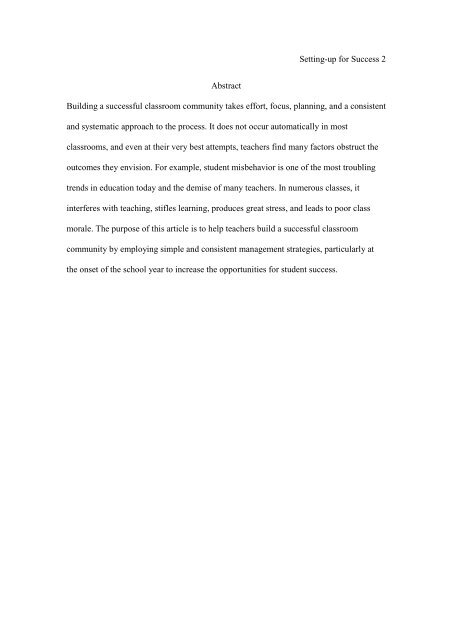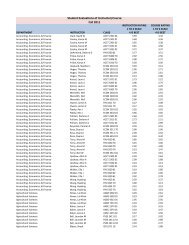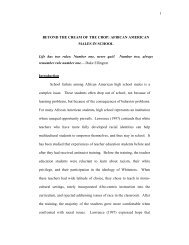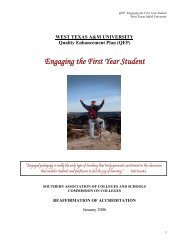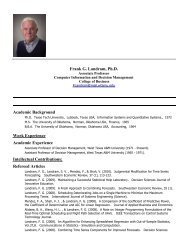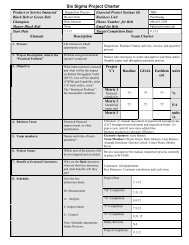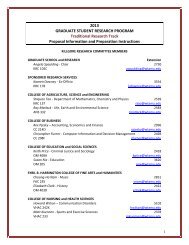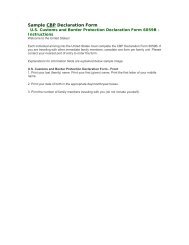Setting-up for success
Setting-up for success
Setting-up for success
You also want an ePaper? Increase the reach of your titles
YUMPU automatically turns print PDFs into web optimized ePapers that Google loves.
<strong>Setting</strong>-<strong>up</strong> <strong>for</strong> Success 2AbstractBuilding a <strong>success</strong>ful classroom community takes ef<strong>for</strong>t, focus, planning, and a consistentand systematic approach to the process. It does not occur automatically in mostclassrooms, and even at their very best attempts, teachers find many factors obstruct theoutcomes they envision. For example, student misbehavior is one of the most troublingtrends in education today and the demise of many teachers. In numerous classes, itinterferes with teaching, stifles learning, produces great stress, and leads to poor classmorale. The purpose of this article is to help teachers build a <strong>success</strong>ful classroomcommunity by employing simple and consistent management strategies, particularly atthe onset of the school year to increase the opportunities <strong>for</strong> student <strong>success</strong>.
<strong>Setting</strong>-<strong>up</strong> <strong>for</strong> Success 3<strong>Setting</strong>-<strong>up</strong> <strong>for</strong> Success: Building a Successful Classroom CommunityThrough Classroom ManagementBuilding a <strong>success</strong>ful classroom community takes ef<strong>for</strong>t, focus, planning, and aconsistent and systematic approach to the process. It does not occur automatically in mostclassrooms and even at their very best attempts, teachers find many factors obstruct theoutcomes they envision. For example, student misbehavior is one of the most troublingtrends in education today and the demise of many teachers. In numerous classes, itinterferes with teaching, stifles learning, produces great stress, and leads to poor classmorale. It <strong>up</strong>sets both teachers and students and ruins many classes. It causes moreteachers to fail than does any other factor (Charles, 2008). However, that need not be thecase. According to Charles (2008), misbehavior can easily be brought to manageableproportions by employing three strategies simultaneously. The first is to prevent theoccurrence of misbehavior as much as possible. The second is to introduce classroomconditions that lead to student enjoyment, sense of purpose, self-direction, and sense ofresponsibility. The third is to manage misbehavior in a positive manner rather than anegative one. The purpose of this article is to help teachers build a <strong>success</strong>ful classroomcommunity by employing simple and consistent management strategies, particularly atthe onset of the school year to increase the opportunities of <strong>success</strong> <strong>for</strong> both students andteachers.Prevention: Begin with the end in mindBuilding a positive classroom community through classroom management is notabout achieving order <strong>for</strong> the sake of order. It is about achieving a sense of balance sothat productive learning can occur. To increase learning, teachers must do all they can to
<strong>Setting</strong>-<strong>up</strong> <strong>for</strong> Success 4prevent misbehaviors so that teaching and learning can take place. Preventing refers tothose teacher behaviors and actions that prevent discipline problems and lead to higherrates of student engagement (Curwin & Mendler, 2000). Be<strong>for</strong>e the first student entersthe classroom, teachers need to think about expectations <strong>for</strong> behavior, conditions thatmust be in place to prevent otherwise, and how they will demonstrate authority tostudents. Teacher authority is an elusive, but extremely important, element that maymake a crucial difference between <strong>success</strong> and failure in classroom management (Yell,Meadows, Drasgow, & Shriner, 2009; Savage, 1999).In facilitating a seamless start to instruction, rules <strong>for</strong> conduct need to beidentified, in addition to general behavioral routines that teachers and students willfollow. It is important to answer the questions: What will students do when they enter theroom? Are students expected to go immediately to their seats or will they socialize insmall gro<strong>up</strong>s until directed? What is the teacher s<strong>up</strong>posed to be doing at this time? It iseasy to underestimate the importance of clear and consistent routines and relevance toclassroom order, as they may appear to be mundane and trivial issues. However, withoutthese customs, students will do as they please. These actions may not be in the bestinterest of everyone, nor conducive to a productive learning environment. Yell et al.(2009) found teachers who are <strong>success</strong>ful classroom managers prevent problem behaviorsfrom occurring rather than merely reacting to problems that have already occurred.Effective classroom management begins with advanced planning by teachers(Good & Brophy, 2008) and includes the understanding and developing of personalmanagement systems based on sound principles and guidelines s<strong>up</strong>ported by empiricalevidence and in<strong>for</strong>mation (Yell et al. 2009). Because students do not automatically know
<strong>Setting</strong>-<strong>up</strong> <strong>for</strong> Success 5how to behave when they first arrive to a classroom, teachers must communicate positiveexpectations, teach the behaviors they would like to see displayed, provide models andopportunities <strong>for</strong> practice, and use positive rein<strong>for</strong>cement to increase the probability thatappropriate behaviors will continue to occur in the future. Good and Brophy (2000)observed that “four things can happen” when students must wait with nothing to do and“three of them are bad: (1) students may remain interested and attentive; (2) they maybecome bored or fatigued, losing interest and ability to concentrate; (3) they may becomedistracted or start daydreaming; or (4) they may actively misbehave” (p. 131). Given thethree-to-one odds that waiting will result in undesirable behavior and a loss of valuablelearning opportunities (Weinstein & Mignano, 2003), it is essential <strong>for</strong> teachers to learnhow to maintain the flow of classroom activities over the duration of the school day.In considering ways to increase opportunities to learn while preventing misbehaviors, it iseasy to go overboard in this search (Weinstein & Mignano, 2003). For example,expecting students to be on-task 100% of the time is foolish. Total engagement is noteasy <strong>for</strong> anyone and it is especially difficult <strong>for</strong> students who must work on tasks theyhave not selected and sometimes find tedious and irrelevant (Weinstein & Mignano,2003). There<strong>for</strong>e, teachers must carefully determine the needs of students in each settingand remain realistic while working to maintain balance. Barbara Coloroso emphasizedthe ultimate purpose of discipline is to enable students to make intelligent decisions,accept the consequences of their decisions, and use the consequences to help them makebetter decisions in the future (as cited in Charles, 2008). However, to achieve the most<strong>success</strong>, teachers must truly believe students are worth every ef<strong>for</strong>t made on their behalf.
<strong>Setting</strong>-<strong>up</strong> <strong>for</strong> Success 6Introduce classroom conditions that lead to <strong>success</strong>Essential to classroom management is the ability of teachers to reasonably predictwhat variables are likely to have a negative impact on students. Successful teachers payattention to, and control antecedents be<strong>for</strong>e they disr<strong>up</strong>t classroom order. An antecedentis an event that precedes a behavior and influences the probability that it will recur in thefuture. It can cue either appropriate or inappropriate behavior (Munk & Repp, 1994).Schloss and Smith (1998) encouraged teachers evaluating their classrooms or establishingnew ones to ensure antecedents control techniques are present due to their importance inpreventing classroom disr<strong>up</strong>tions and inappropriate behaviors. In a review of theliterature conducted to identify evidence-based practices, Simonsen, Fairbanks, Briesch,Myers, and Sugai (2008) found that effective classroom managers: (a) maximizestructure; (b) post, teach, review, monitor, and rein<strong>for</strong>ce expectations; (c) actively engagestudents in observable ways; (d) use a continuum of strategies <strong>for</strong> responding toappropriate behaviors; and (e) use a continuum of strategies to respond to inappropriatebehaviors. In addition to those practices, the following list includes importantconsiderations <strong>for</strong> teachers to incorporate as they set-<strong>up</strong> classrooms to be more effectiveand efficient:Be welcoming. In setting-<strong>up</strong> <strong>for</strong> <strong>success</strong>, teachers need to be welcoming. Jones(2007) maintains good discipline depends in large measure on teachers making effectiveuse of body language, <strong>for</strong> example, teachers’ facial expressions can show enthusiasm,seriousness, enjoyment, and appreciation, all of which encourage good behavior. While itis important to have high expectations and set standards <strong>for</strong> behavior from the first day ofschool, it is imperative to assess differences between having a structured environment
<strong>Setting</strong>-<strong>up</strong> <strong>for</strong> Success 7and one that conveys the impression that any behavior will be tolerated. Structure andorganization do not mean an absence of humor, kindness, and respect. Yell et al. (2009)found a positive classroom climate encourages learning, promotes good behavior, andrewards student accomplishment. In contrast, a poor classroom climate is disorganizedand cold, and emphasizes obedience and duress. Such environments can depress learningand lead to misbehavior (Yell et al. 2009). For the first day of school, Weinstein andMignano (2003) recommend teachers greet students warmly as they enter classrooms,help them to get nametags on, and get them seated. As students observe the positiveattitude and deportment displayed by teachers, they will see models of how to behave andperhaps in turn emulate these behaviors.Be clear about rules and procedures. Both rules and procedures refer to statedexpectations or standards <strong>for</strong> behavior. While some rules and procedures are classroomspecific, teachers are expected in most schools to en<strong>for</strong>ce general school rules. These arethe expectations required <strong>for</strong> all classes and usually found in the schools’ code ofconduct. Rules and procedures are important in achieving an environment that is calm,orderly, and productive. Evertson, Emmer, and Worsham (2003) found rules should bediscussed with students on the first day or two of class, and that they should be posted toallow teachers to focus attention on, and create a strong expectation about importantbehaviors. It is insufficient to simply state rules. Teachers must teach rules to students asthey do other concepts where examples and non-examples can help to specify what therules “look” like. Students who see the behavior associated with each rule demonstratedand have an opportunity to practice that behavior have more <strong>success</strong> following the rules.Rules that are rehearsed be<strong>for</strong>e a lesson are more likely to be followed during the lesson.
<strong>Setting</strong>-<strong>up</strong> <strong>for</strong> Success 8This is especially important <strong>for</strong> children with cognitive, emotional and behavioraldisorders, and elementary aged children. Three to five positively stated rules arerecommended <strong>for</strong> most classroom settings and major consequences associated with rulesshould be described at the same time rules are presented to students (Evertson et al.2003).Although setting rules and procedures are largely teacher-centered practices, ademocratic approach can ensure a child-centered process. For example, in a studydesigned to determine how to build democratic classrooms in terms of teachers’ views,Kesici (2008) found teachers who build democratic classrooms have a duty to provideshared decision-making, equality, and effective communication, establish studentcenterededucation, give importance to students, treat students fairly, and allow studentsto express ideas freely. In order to build democratic classrooms, decisions should beconsistently made by both students and teachers. Selvi (2006) found teachers' democraticvalues and behaviors affect the behaviors of students and encouraged teachers to beconsistent in not only what they do, but also what to say to students. Inviting students toparticipate in setting rules and procedures advances a child-centered focus and a sense ofequality as students work together with teachers to determine what is important <strong>for</strong>everyone.Establish routines. Consistent routines help students learn expectations <strong>for</strong>working both in classrooms and in preparation <strong>for</strong> activities within the larger schoolcommunity, and beyond. Teaching students in advance how to handle simple academicand non-academic routines increases independence and reduces the need to interr<strong>up</strong>tteachers and peers. In establishing routines, teachers need to lead by example.
<strong>Setting</strong>-<strong>up</strong> <strong>for</strong> Success 9Bartholomew (2007) found a well-managed classroom results from good organization,clear expectations, positive teacher communication, and valuing student input andengagement. Teachers must also model and en<strong>for</strong>ce the kind of respectful interchangethey expect.Teachers can use a daily schedule to help students learn and practice routines. Awell-designed classroom schedule ensures that important curricular areas receivesufficient attention and allows everyone to predict what will occur during the school day.However, schedules are only effective if teachers actually follow them. Routines becomeeasier <strong>for</strong> students to learn and do when teachers are consistent in following schedulesand in<strong>for</strong>ming students ahead of time what needs to be done and when changes need to bemade. Jones (2007) reported class sessions in most schools begin in a fragmented way,with announcements, taking attendance, and handling tardies. This fragmentation wastestime, fosters misbehaviors, and makes it more difficult <strong>for</strong> students to follow and adjustto routines. To remedy that situation, Jones encouraged teachers to begin class with bellwork, which does not require active instruction but provides engagement and focus <strong>for</strong>students as they begin the day. Most students can participate in, and derive some benefitsfrom routine bell work. Additional areas in the daily schedule where students couldbenefit from routines include: transitions between subjects, classes, activities, lunch,dismissal, emergency drills, and restroom breaks.Be systematic about instruction. A proactive variable that is under teacher control,and critical to academic achievement and appropriate classroom behavior, is the amountof time in which students are involved in academic tasks (Yell et al. 2009; Good &Brophy, 2008). When students have nothing to do, or are engaged in boring activities,
<strong>Setting</strong>-<strong>up</strong> <strong>for</strong> Success 10misbehavior becomes more likely (Yell et al. 2009). There<strong>for</strong>e, careful selection and useof teaching procedures and techniques such as task analysis, shaping, and prompting canreduce student boredom and frustration and motivate students to stay on task. Taskanalysis involves breaking a complex skill into smaller, teachable units, the product ofwhich is a series of sequentially ordered steps or tasks (Cooper, Heward, & Heron, 2007).For learners who are younger, or have disabilities, or may experience difficulty inlearning new skills, the technique called shaping can be helpful. Shaping is the process ofrein<strong>for</strong>cing <strong>success</strong>ive approximations of a skill until the student can per<strong>for</strong>m itaccurately each time (Schloss & Smith, 1998). Occasionally during a lesson, studentsmay hesitate or incorrectly answer a question or per<strong>for</strong>m a skill. Teachers can assist byproviding prompts or cues to increase the probability that the student will answer orper<strong>for</strong>m correctly. A systematic approach to instruction is required <strong>for</strong> children receivingspecial education services where carefully planned instruction must be goal directed andfocused on individual needs. Further, it must be empirically s<strong>up</strong>ported and drawn fromresearch (NCLB, 2001; IDEA, 2004). Although this method is most often implementedby special education classrooms, this approach to instruction benefits all varieties oflearners.Teachers can avoid problems that result from boredom and frustration by teachingfunctional, age-appropriate activities and use materials that make lessons more interestingand enhance students’ ability to function in community settings. In a study that examinedteacher reflection, parental concern, leadership and developmentally appropriatepractices, Chen and Battin-Sacks (2008) recommend teachers always consider the child’spoint of view as developmentally appropriate practice is, after all, about the children and
<strong>Setting</strong>-<strong>up</strong> <strong>for</strong> Success 11what is meaningful and relevant to them. Further, children have a natural capacity <strong>for</strong>questioning, reasoning, thinking, and decision-making. There<strong>for</strong>e, it is important toreview the educational program of students, carefully monitor the rate of <strong>success</strong> and takeresponsibility <strong>for</strong> changing instruction when the monitoring data indicate sufficientprogress is not being made. This is a critical component <strong>for</strong> teachers of students withspecial needs who must make sure goals and objectives are appropriate and are masteredat the expected rate.Make management a process, not an eventManaging students positively requires teachers to plan, reflect, and followthroughconsistently to produce <strong>success</strong>ful results. It is a process or course of action, notarbitrary responses to events of misbehavior. Teachers can become effective managers byunderstanding and developing personal management systems s<strong>up</strong>ported by empiricalevidence and in<strong>for</strong>mation (Yell et al. 2009). To be most effective, teachers must alsoconsider procedures that extend beyond the classrooms and relate to families asnecessary. The following strategies when applied consistently can help teachers build amanagement system that is based on a method or course of action, rather than by simplyresponding to events of misbehavior.Create a safe and positive classroom community. Kohn (2001) described acommunity as a “place in which students feel cared about and are encouraged to careabout each other. They experience a sense of being valued and respected; children matterto one another and to the teacher. They have come to think in the plural; they feelconnected to each other; they are part of an ‘us.’ and, as a result of this, they feel safe intheir classes, not only physically but emotionally” (pp. 101-102). Building a <strong>success</strong>ful
<strong>Setting</strong>-<strong>up</strong> <strong>for</strong> Success 12classroom community requires consideration of the environment, the best fit, and safety<strong>for</strong> all students. Consequently, in well-organized classrooms, teachers work to develop astructure that is predictable and a physical environment that is conducive to learning(Yell et al. 2009).Be sensitive to students’ needs and concerns. Sensitivity appears to be aprerequisite quality <strong>for</strong> individuals in the teaching profession where communication isvital in building relationships, especially with children who are culturally andlinguistically diverse. According to Curwin and Mendler's principal teachings, teachersare encouraged to always treat students with dignity, to respect them as individuals, showconcern <strong>for</strong> their needs, and understand their viewpoints (as cited in Charles, 2005). Inaddition, Curwin and Mendler advised teachers to ask themselves the following questionwhen reacting to student misbehavior: “How would this strategy affect my dignity if ateacher did this to me?” When teachers take time to show students that they not onlyunderstand, but also care, they show through actions that the classroom is a communitywhere everyone is valued.Model and practice what is taught. Being the teacher does not exempt one fromfollowing the rules that are in place. Sometimes without intending to do so, teachers oftenviolate their own rules. For example, chewing gum or talking on cell phones duringclasses, when students are expressly <strong>for</strong>bidden to do either, is unacceptable. Childrenhave a natural propensity <strong>for</strong> making sense of their world by drawing conclusions fromtheir experiences. Consequently, it is important <strong>for</strong> teachers to be conscious ofunintended messages sent by actions displayed (Chen & Battin-Sacks, 2008). There<strong>for</strong>e,teachers must model appropriate behaviors, including self-discipline and self-control
<strong>Setting</strong>-<strong>up</strong> <strong>for</strong> Success 13(Hallenbeck & Kauffman, 1995; Kauffman, 2005). If the rules selected are reasonableand necessary from the onset of the school year, they should be relatively easy <strong>for</strong>everyone to follow. The notion of accountability should be evident in the teachers’conduct as he or she manages and guides students through their development. It isimportant to remember that many students keep a constant focus on their teacher,observing everything they do and learning much from what they say in addition to theemotions expressed even in silence. Chubbuck and Zembylas (2008) found emotions aretrans<strong>for</strong>mative in that they are not peripheral by-products of events, but rather they areconstitutive <strong>for</strong>ces <strong>for</strong> trans<strong>for</strong>ming individuals, social interactions, and power relations.Consequently, how teachers behave may just be as important as what they teach studentsabout behaviors.Incorporate the characteristics of good teaching. Research on the foundation ofteacher effectiveness (Eggen & Kauchak, 2006) suggests regardless of the teachers’personality, or background, grade-level of students, or the topic being studied, someteacher actions increase student learning more than others. These actions or essentialteaching strategies are the teacher attitudes and skills necessary to ensure that all studentslearn as much as possible. Eggen and Kauchak (2006) outlined the followingcharacteristics as the basic skills of teaching:Teacher characteristics. Teacher characteristic such as personal teaching efficacy,modeling and enthusiasm, caring, and high expectations promote learnermotivation, They are also strongly linked to increased student achievement(Bruning, Schraw, Norby, & Ronning, 2004; Shuell, 1996).
<strong>Setting</strong>-<strong>up</strong> <strong>for</strong> Success 14Communication. The importance of teachers being able to communicate clearly isintuitively sensible, and research documents a strong link between teachers’ability to communicate and student achievement, as well as student satisfactionwith instruction (Snyder et al. 1991). The following elements of effectivecommunication influence learning: precise terminology, connected discourse,transition signals, and emphasis.Organization. The importance of organization in teaching cannot be overstated.Teachers who are organized have students who learn more than their lessorganized counterparts (Eggen & Kauchak, 2004).Instructional Alignment. Instructional alignment describes the congruence amongobjectives, learning activities, and assessments (Brans<strong>for</strong>d, Brown, & Cocking,2000). Although the notion of instructional alignment seems simple, a surprisingnumber of teachers have objectives and learning activities that are not consistent,and, in some cases, the instruction doesn’t seem to be directed to any particularobjective. This match between objectives, activities, and assessments is essentialif teachers are to help students.Focus. Focus is provided through stimuli that maintain students’ attention duringlearning activities. The stimuli can be concrete objects, pictures, models, ormaterials displayed on the overhead, and even in<strong>for</strong>mation written on thechalkboard. The more concrete and attractive the materials, the better.Feedback. Feedback is in<strong>for</strong>mation about current behavior that can be used toimprove future per<strong>for</strong>mance and its importance is confirmed by both theory andresearch (Eggen & Kauchak, 2004). Regardless of the topic, grade level, or task,
<strong>Setting</strong>-<strong>up</strong> <strong>for</strong> Success 15students who receive detailed feedback about their learning progress achievehigher than those receiving less feedback (Good & Brophy, 2000). Effectivefeedback has three essential characteristics that are equally important <strong>for</strong> bothwritten and verbal feedback. Effective feedback provides specific in<strong>for</strong>mation, isdependent <strong>up</strong>on per<strong>for</strong>mance, and has a positive emotional tone.Monitoring. Monitoring is the process of continually checking students’ verbaland nonverbal behavior <strong>for</strong> evidence of learning progress. It is important duringall learning activities (and particularly during seatwork, when students may bemaking repeated errors). Alert teachers immediately recognize when studentsbecome inattentive and move near them or call on them to bring them back intolessons. Effective teachers also respond to nonverbal behaviors such as puzzledlooks on students’ faces. Careful monitoring followed by appropriate teacherresponses can strongly contribute to a climate of s<strong>up</strong>port while simultaneouslydemonstrating high expectations <strong>for</strong> behavior and learning.Questioning. Social interaction is one of the principles of cognitive learningtheory and questioning is the most effective strategy teachers have <strong>for</strong> promotingthis interaction (Wang, Haertel, & Walberg, 1993). Expert teachers usequestioning to help students see connections between the abstract ideas they arestudying by relating them to real world examples (Brown, 1994; Eggen &Kauchak, 2004). Questioning can also help maintain attention, involve shy andreluctant students, provide emphasis through repetition, and assess studentunderstanding.
<strong>Setting</strong>-<strong>up</strong> <strong>for</strong> Success 16Review and Closure. Review is the process of summarizing previous work and<strong>for</strong>ming a link between prior learning and the present topic. Closure is a <strong>for</strong>m ofreview that occurs at the end of a lesson. Coming to a close at the end of a lessonis important. This is the last in<strong>for</strong>mation that students take away from the class,and if ideas aren’t clear, the students may develop (and remember)misconceptions that can be difficult to dispel.Move beyond parental involvement to collaboration with families. One of themost important and often overlooked components of building a <strong>success</strong>ful classroomcommunity is the impact of working with families. Teachers and parents have a commongoal <strong>for</strong> children to be <strong>success</strong>ful. Fulfilling that objective requires a true collaborativepartnership. Collaboration is more than merely keeping in touch with parents andin<strong>for</strong>ming them of <strong>up</strong>coming events. Friend and Cook (2007) described collaboration as astyle that professionals use to interact with one another. This is a style based on valuingone another’s contribution, trusting and respecting one another, and sharing the workload.Friend and Cook (2007) also emphasized collaboration as a key ingredient <strong>for</strong> teachingdiverse student gro<strong>up</strong>s. Consequently, when families understand what a teacher is tryingto achieve, they can provide valuable s<strong>up</strong>port and assistance. Teachers should avoidcontacting parents only to report on students’ inappropriate behaviors. Parents appreciatehearing good news from teachers and an on-going dialogue between home and school hasshown to reduce classroom conflicts <strong>for</strong> children. For example, Hiatt-Michael (2001)found parent involvement promotes better student attendance, increased graduation rates,less grade retention, higher parent and student satisfaction with school, less disciplinereports, and higher achievement scores in reading and math. In building a classroom
<strong>Setting</strong>-<strong>up</strong> <strong>for</strong> Success 17community, collaborative partnerships between stakeholders will ensure that parents are apart of the total process, which includes planning and s<strong>up</strong>porting, instead of only beingrecipients of news about their child and <strong>up</strong>dates regarding class and school in<strong>for</strong>mation.The quest <strong>for</strong> a <strong>success</strong>ful classroom community is not separate from academiclearning. Significant emphasis is devoted in schools today to curriculum and instruction,lesson planning, resources, and leadership, yet, very little planning goes into thefoundation on which the other critical dimensions of excellence stand. That foundation isthe classroom community where children feel connected and safe; where children aretreated with dignity and respect; where responsibility is more important than obedience;and where the ultimate goal of instruction is independence. However, the current trend ofclassroom disr<strong>up</strong>tions prevents student <strong>success</strong> and causes more teachers to fail than anyother factor (Charles, 2008). With the mandates of the No Child Left Behind Act (NCLB;2001), teachers are responsible <strong>for</strong> students' learning outcomes at various levels. Inaddition, research indicates that teachers’ classroom management skills are of crucialimportance in determining teacher and student <strong>success</strong> (Yell et al. 2009; Evertson et al.2003). Given the relationship between student outcomes and teacher knowledge andskills, teachers must employ proactive management strategies consistently in order toenhance student achievement. Beginning teachers face innumerable challenges (Liston,Whitcomb, & Hilda, 2006) that aren't always fully conceptualized while working throughteacher education programs (Sutliff, Higginson, & Alstott, 2008). For example,establishing routines, and providing instruction while students are unmotivated,aggressive, and violent is not easy. While universal prevention programs and targetedtreatment strategies are needed to address systemic problems in education, to achieve
<strong>Setting</strong>-<strong>up</strong> <strong>for</strong> Success 18<strong>success</strong>, teachers must be competent and effective classroom managers. While managingstudents can be daunting, even <strong>for</strong> experienced teachers who are well prepared, it is notan impossible task or an unattainable goal. In setting-<strong>up</strong> classrooms or evaluating newones, teachers must prevent misbehaviors, introduce classroom conditions that lead to<strong>success</strong>, and recognize that management should be based on a process and course ofaction. Considering the demands of a classroom teacher, the significant responsibilities,challenges inherent in the role, and the scope and potential outcomes <strong>for</strong> students, it isclear that building a <strong>success</strong>ful classroom community has never been more difficult, norhas it ever been more important and deserving of attention and action from all teachers.
<strong>Setting</strong>-<strong>up</strong> <strong>for</strong> Success 19ReferencesBartholomew, B. (2007). Why we can’t always get what we want. Phi Delta Kappan,88(8), 593-598.Brans<strong>for</strong>d, J., Brown, A., & Cocking, R. (2000). How people learn: Brain, mind,experience, and school. Washington, DC: National Academy Press.Brown, A. (1994). The advancement of learning. Educational Researcher, 23, 4-12.Bruning, R., Schraw, G., Norby, M., & Ronning, R. (2004). Cognitive psychologyand instruction (4 th ed.). Upper Saddle River, NJ: Prentice Hall.Charles, C. M. (2008). Building classroom discipline (8 th ed.). Pearson Education, Inc.Chen, D. W., & Battin-Sacks, P. (2008). When will I be special? Rethinkingdevelopmentally appropriate practice in a classroom routine. Young Children,63(3), 44-51.Chubbuck, S. M., & Zembylas, M. (2008). The emotional ambivalence of socially justteaching: A case study of a novice urban schoolteacher. American EducationalResearch Journal 45(2), 274-318.Cooper, J. O., Heron, T. E., & Heward, W. L. (2007). Applied Behavior Analysis (2 nded.). Upper Saddle River, NJ: Pearson/Merrill Prentice Hall.Curwin, R. L., & Mendler, A. N. (2000). Discipline with dignity. (2 nd ed.). Upper SaddleRiver, NJ: Merrill/Prentice Hall.Eggen, P., & Kauchak, D. (2006). Strategies and models <strong>for</strong> teachers: Teaching contentand thinking skills, (5 th ed.). Pearson Education, Inc.Eggen, P., & Kauchak, D. (2004). Educational psychology: Windows on classrooms,(6 th ed.). Upper Saddle River, NJ: Merrill/Prentice Hall.
<strong>Setting</strong>-<strong>up</strong> <strong>for</strong> Success 20Evertson, C. M., Emmer, E. T., & Worsham, M. E. (2003). Classroom management<strong>for</strong> elementary teachers, (6 th ed.). Boston: Allyn and Bacon.Friend, M., Cook, L. (2007). Interactions: Collaboration skills <strong>for</strong> schoolprofessionals, (4th ed.). Boston: Allyn and Bacon.Good, T., & Brophy, J. (2000). Looking in classrooms, (9 th ed.). Boston: Allyn & Bacon.Good, T., & Brophy, J. (2008). Looking in classrooms, (10 th ed.). Boston: Allyn &Bacon.Hallenbeck, B. A., & Kauffman, J. M. (1995). How does observational learning affect thebehavior of students with EBD. The Journal of Special Education 29, 45-71.Hiatt-Michael, D. 2001. Preparing teachers to work with parents. ERIC EC Digest #460123.IDEA (Individuals with Disabilities Education Act, Reauthorization). 2004. P. L. 108446. Washington, DC: U. S. Department of Education. Available at:http://idea.ed.gov/explore/homeJones, F. (2007). Fred Jones tools <strong>for</strong> teaching. Santa Cruz, CA: Fredric H. Jones &Associates.Kauffman, J. M. (2005). Characteristics of emotional and behavioral disorders inchildren and youth, (8 th ed.). Upper Saddle River, NJ: Merrill/Prentice Hall.Kesici, S. (2008). Teachers opinion about building a democratic classroom. Journal ofInstructional Psychology 35(1), 192-203.Kohn, A. (2001). Beyond discipline: From compliance to community. Upper SaddleRiver, NJ: Merrill/Prentice Hall.
<strong>Setting</strong>-<strong>up</strong> <strong>for</strong> Success 21Liston, D., Whitcomb, J., & Hilda, D. (2006). Too little or too much: Preparation and thefirst years of teaching. Journal of Teacher Education 57(4), 351-358.Munk, D., & Repp, D. D. (1994). The relationship between instructional variables andproblem behavior. Exceptional Children 60(5), 390-401.No Child Left Behind Act. (2001). P. L. 107-110. Washington, DC: U. S. Department ofEducation. Available at: www.ed.gov/policy/elsec/leg/esea02/index.html.Savage, T. V. (1999). Teaching self-control through management and discipline (2 nd ed.).Boston: Allyn & Bacon.Schloss, P. J., & Smith, M. A. (1998). Applied behavior analysis in the classroom.Boston: Allyn & Bacon.Selvi, K. (2006). Developing a teacher trainees' democratic values scale: validity andreliability analyses. Social Behavior and Personality 34(9), 1171-1178.Shuell, T. (1996). Teaching and learning in a classroom context. In D. Berliner & R.Calfee (Eds.), Handbook of educational psychology, (pp.726-764). New York:Macmillan.Simonsen, B., Fairbanks, S., Briesch, A., Myers, D., & Sugai, G. (2008). Evidence-basedpractices in classroom management: Considerations <strong>for</strong> research to practice.Education and Treatment of Children 31(3), 351-380.Snyder, S., Bushur, L., Hoeksema, P., Olson, M., Clark, S., & Snyder, J. (1991, April).The effect of instructional clarity and concept structure on students’ achievementand perception. Paper presented at the annual meeting of the AmericanEducational Research Association Conference, Chicago. Ill.
<strong>Setting</strong>-<strong>up</strong> <strong>for</strong> Success 22Sutliff, M., Higginson, J. & Alstott. S. (2008). Building a positive learning environment<strong>for</strong> students: Advice to beginning teachers. Strategies 22(1), 31-33.Wang, M., Haertel, G., & Walberg, H. (1993). Toward a knowledge base <strong>for</strong> schoollearning. Review of Educational Research 63(3), 249-294.Weinstein, C. S., & Mignano, A. (2003). Elementary classroom management: Lessonsfrom research to practice. McGraw Hill.Yell, M. L., Meadows, N. B., Drasgow, E. & Shriner, J. G. (2009). Evidence-basedpractices <strong>for</strong> educating students with emotional and behavioral disorders. NJ:Merrill.


